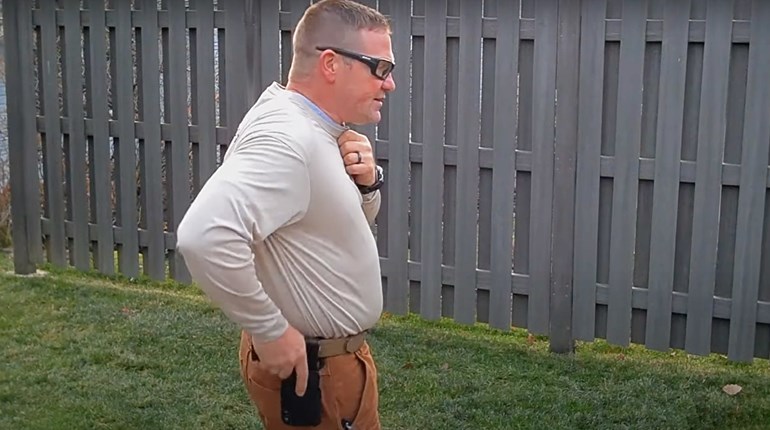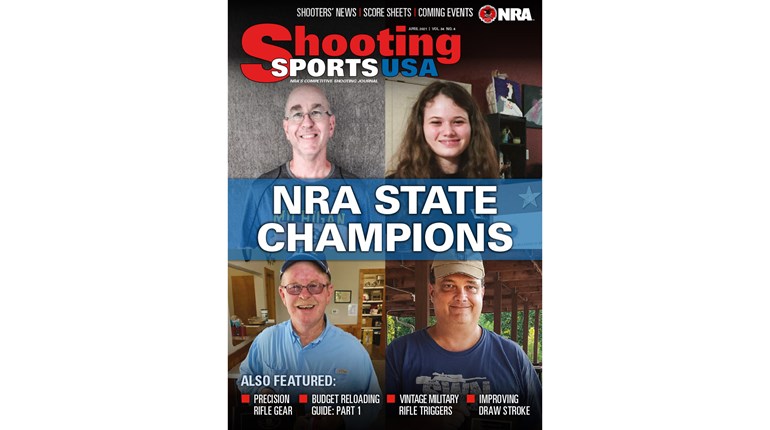
Jumping into the Carry Life is not a trivial undertaking. Getting the legal aspects right for a given jurisdiction is certainly no walk in the park, to say nothing of selecting an appropriate firearm, carry method (holster, pocket, purse, etc.) and carry position (appendix, hip, kidney, etc.). As we said—not trivial.
Don’t hate us, though, if we have another factor we feel duty-bound to add to these many considerations: What, precisely, is “staging,” and does—or should—it change your carry calculus? To the foregoing, we reply with our most definitive, incisive, “Uh, maybe.” … When it comes to a defensive shooting situation, there’s an argument to be made that there is no such thing.
A little terminology clarification to start: Staging is an optional, carry-only preparation of the draw stroke, not—repeat not—a “faked” draw of any kind. Even in IDPA, the competition discipline for carry, it would be considered cheating: “Creeping” is the actual term, though it’s best understood as simply jumping the gun at the start buzzer, however slowly or quickly the actual motion proceeds. Many other disciplines share the name and penalize its repetition, though generally after a warning.
But back to the “cheating” business: When it comes to a defensive shooting situation, there’s an argument to be made that there is no such thing. Staging as a technique improvement is best thought of as a pre-movement to your defensive firearm, but which stops short of an actual draw. It can be a huge advantage. Staging as a mindset improvement may put you inside an attacker’s OODA loop, actually making de-escalation or safe withdrawal more likely—always preferable in our book.
Some modes of carry, most notably pocket or purse, obviously lend themselves to staging (to gain draw speed by cutting presentation time). When Col. Cooper’s color codes of awareness change from yellow to orange, the draw hand (presumably strong/master hand) moves to a full grip and remains there, though with the finger off the trigger (since you are not on target and ready to fire). A potential downside is that such movement may be of relatively large amplitude and pace, and as such a situational non sequitur, but at least your firearm remains discreet.
If you carry at the belt—mainly hip or kidney—those large-amplitude movements are all but guaranteed. Especially if a cover garment is in play, the necessary motions can only be subtle if executed slowly—often so slowly the advantage of staging in the sense of “speed” is mostly compromised. A more serious consequence attends, however: Your defensive wherewithal is now unmasked unless your carry is “open,” and this skirts brandishing in some jurisdictions. Wise concealed-carry practitioners know they cannot afford to be seen as the aggressor, and both unmasking and large-amplitude, rapid movements are unhelpful in this respect. If you must draw and engage, you’ll be able to do so in half the time (plus reaction time).
But staging is probably best applied when the carry position is on the front third of the torso. In either appendix, with the firearm in the waistband on the strong side, somewhere forward of the hip but short of midline, or cross draw—gasp! (yes, we know, but it’s making a cautious but deserved comeback)—only very small-amplitude motions are needed to complete the grip. Sliding the hand up under the cover garment behind the firearm and then over the grip helps here. With practice, concerns of unmasking will fade completely, and gratifying speed takes their place.
Here’s the point: If your circumstances transition from Cooper’s orange to red, you’ve now pre-fabricated the slowest, most mishap-prone components of your draw stroke. If you must draw and engage, you’ll be able to do so in roughly half the interval (plus reaction time). But if circumstances improve and the threat abates, you can de-escalate, all without movements or exposed capacity that could alarm or confuse bystanders.
We’d also posit a second benefit of staging. In an odd twist, it works inversely to the mechanical efficacy we’ve identified. While front-of-body positions of carry allow for the “best” staging in the sense of being discreet and rapid, pocket or hip/kidney staging is the most imposing: For the same reasons that it’s the least discreet, it’s also the most effective in communicating “I’m aware and prepared.”
We get that this effect is derided in many circles, and understand—and to an extent, even agree—with why: Upping the ante in an intimidation game is unpredictable at the very best. But to insist that bullies or out-and-out crooks can’t or don’t make risk/reward decisions based on such criteria is its own sort of dangerous basura. This has happened to us: When five ugly drunks decided they weren’t going to follow the rules when we were acting in known, sanctioned capacity, they closed distance for who-knows-what. Staging to a Condition Two Walther PPK stopped their advance in a single pace, at a distance where safe retreat was still an option, and taken. There were no shots fired, thankfully, but no brandishing worries or five-on-one head injuries, either. … Staging is a versatile way to buy those potentially life-saving seconds.
For the statistics wonks and simple deniers out there, we add that this is not the only case of which we have firsthand (or vetted second-hand) knowledge. Claim this “never happens,” if you like; just know for certain you’re lying to make your point. Of course that would be new in what substantive way? But we digress …
No sharp recommendations close our considerations. Carry has so many variables that what is clearly best for one—or thousands—may not even be safe (to say nothing of effective) for many, many others. But whatever your carry method or position, a knowledge of how staging improves or detracts from your choices can only help. Whether it adds deceptive speed in dire emergency or reflects back a little justified menace of your own is a call only you can make. Not for the first time, we suggest that a covered retreat is always the preferred option, and staging can be a versatile way to buy those potentially life-saving seconds.
Now Carry on.


































